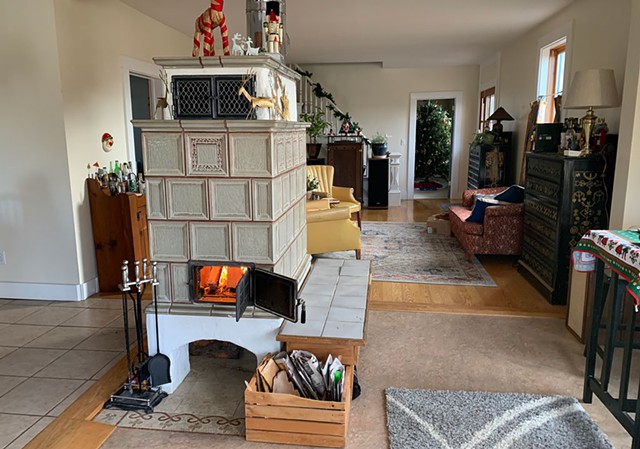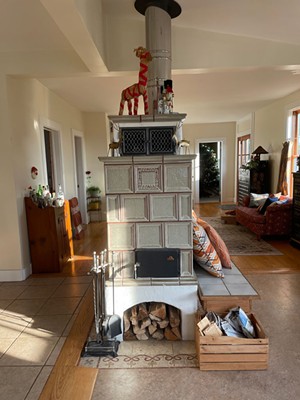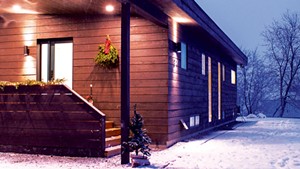
- Courtesy Of Keilani Lime
- A Biofire masonry heater
When my girlfriend and I set out to buy our first home over the summer, our list of must-haves was pretty minimal. You can keep your white kitchens and man caves. For us, the ideal home basically needed three things: yard space, a soaking tub, and a wood-burning fireplace or woodstove. As a native New Englander who's never lived in a home with a real fireplace or woodstove, that last one was especially important to me. My whole life, I've dreamed of having a crackling hearth in the winter.
After several months of searching and visiting just about every relevant listing within an hour of Burlington — and within our modest budget — we finally settled on a house with a big yard and a nice tub. And, yes, I got finally my wood-burning stove, though it's a bit different from what I'd imagined.
In October, we became the proud owners of an 1870s farmhouse in Vergennes and, with it, the rather mystified owners of a kachelöfen. What's a kachelöfen, you ask? That was precisely our question.
In the United States, kachelöfens are better known as masonry heaters — that is, if they're known at all. While they've been popular in Europe for centuries, these large, often ornate wood-burning ovens are nowhere near as common here as their cast-iron cousin, the woodstove.
But masonry heaters, I soon learned, claim several advantages over conventional woodstoves. For one, "kachelöfen" is fun to say in a bad German accent. More importantly, they're more efficient and require less fuel to operate, despite providing continuous, even heat for up to 12 hours per firing. Not only that, they burn cleaner. And finally, they look really cool.
Do a Google image search for "masonry heater," and you'll discover a wide variety of styles and configurations. Some are freestanding and rustic, made of tile or brick. Others are sleek and modern, built into stucco walls and lined with benches. Regardless of the design, masonry heaters tend to be large with comparatively small fireboxes and lots of surface area. In other words, they make an impression.
Ours, in particular, is hard to miss. Covered in off-white ceramic tile, it stands about six feet tall, not including its large stovepipe, and is pretty much the first thing you see when you walk through our front door. It's a monolith in the middle of the living room.
Admittedly, the size and placement of our masonry heater presents certain interior design challenges, especially in an old farmhouse with an already funky layout. But this is more than overcome by the literal radiance of the kachelöfen.
Conventional woodstoves heat mostly through convection — in other words, they heat the air in a given space. While masonry heaters also provide some convection heat, they primarily emit radiant heat. What's the difference?
For one thing, radiant heat is gentler and cleaner than convection, because science.
"What radiant heat does is, it heats objects — people, furniture, floors, walls, ceilings," Heinz Flurer told me. He likened the effect to sitting in a car on a sunny winter day. "The sun is shining through your window, and it doesn't take long for you to become warm," he explained. "That's because the sun is warming you directly through radiant heat."
So, basically, I have a miniature sun in my living room. (I'm only half joking. Witness the subhead of Ken Matesz's kachelöfen bible Masonry Heaters, released in 2010 by Vermont's Chelsea Green Publishing: Designing, Building, and Living With a Piece of the Sun.)

- Courtesy Of Keilani Lime
- A Biofire masonry heater
Back to Flurer: He's the Salt Lake City-based distributor of Austrian-designed Biofire masonry heaters in the United States. Flurer has been selling Biofire kachelöfens in the U.S. — including the one in my living room — since the early 1980s. But he noted that the company, which is based in Salzburg, Austria, has been around for 300 years. (By the way, Flurer pronounces the brand BEE-oh-fire.)
In my quest to learn more about our masonry heater and also avoid blowing up the house, I've been sporadically bugging Flurer with dumb questions via email and the occasional phone call for about two months. Even though I'm not technically a customer — my kachelöfen was built and installed more than a decade ago — he typically responds within an hour or two with helpful insight or advice.
So, how does it all work?
"In a masonry heater, you put your wood and your kindling in, and you light that sucker up," Flurer explained. "And it's going full bore. It really gets roaring in there."
Indeed it does. The firebox of our masonry heater can reach more than 1,500 degrees on a load of 30 to 40 pounds of seasoned wood — small pieces, about enough to fit in a five-gallon bucket. That fire, which burns for about an hour, sends searing gases through a "labyrinth of channels" made of firebricks, which absorb the heat.
"The idea is to start a fire and burn it hot, fast and clean," Flurer continued. "The design is such that it gives that heat back out slowly and evenly over approximately a 12-hour period of time."
And that's precisely what happens. Despite the inferno inside, our masonry heater is never hot to the touch; it simply radiates coziness all day long. The exterior generally stays at a huggable 150 to 170 degrees — yep, sometimes we hug it — which I know from the thermometer in the warming oven atop the heater. That feature came in handy at Thanksgiving. (The warming oven can also be used to slow-bake apples, I recently discovered.)
So far, I've encountered only two downsides to kachelöfens. One, which didn't affect me directly, is the initial cost. On average, a Biofire will run about $30,000 to design and install — the cost of a nice new car, Flurer noted, or more than three times the cost of a typical high-efficiency woodstove.
The second is that our masonry heater doesn't have a hearth, per se — a fact that initially bummed me out. The firebox has a small opening with a solid, cast-iron door that needs to be closed once the fire burns to coals in order to seal in the heat. (It needs to stay closed for at least six hours to allow the hot gases inside to dissipate, otherwise you could damage the oven.) Some masonry heaters do have windowed fireboxes. But since the idea is to burn hot and fast, even those don't quite provide the lingering ambience of a fireplace or woodstove.
"You don't put another log in the fire with a masonry heater," Flurer said.
Still, you'd be hard-pressed to find a more efficient or elegant wood-burning heating system than the kachelöfen. Even Mark Twain said so.
As he wrote of German masonry heaters in 1891 for his book Europe and Elsewhere, published posthumously in 1923, they are "by long odds the best stove and the most convenient and economical that has yet been invented."










Comments
Comments are closed.
From 2014-2020, Seven Days allowed readers to comment on all stories posted on our website. While we've appreciated the suggestions and insights, right now Seven Days is prioritizing our core mission — producing high-quality, responsible local journalism — over moderating online debates between readers.
To criticize, correct or praise our reporting, please send us a letter to the editor or send us a tip. We’ll check it out and report the results.
Online comments may return when we have better tech tools for managing them. Thanks for reading.